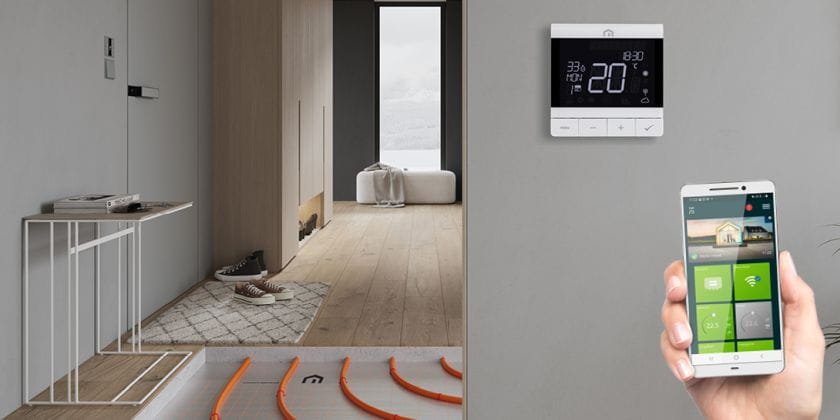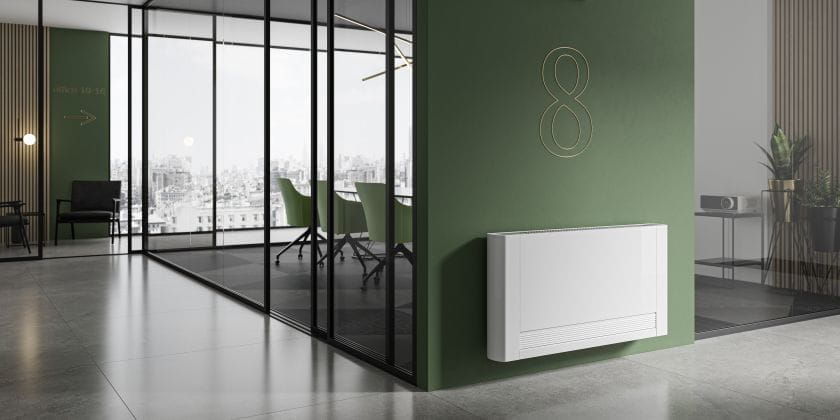- News
- Energy saving
- Hydronic heating
- Electrical heating
HVAC trends in 2025: staying ahead in a transforming industry
HVAC trends in 2025
From a stronger emphasis on energy efficiency and sustainability to the electrification of systems in support of decarbonization goals, the industry is leaning toward greener, smarter, and more integrated solutions this year. An evolution that goes hand in hand with our building stock becoming increasingly well insulated, making it possible to improve and create more effective hvac systems tailored to various applications.
Moreover, smart systems are becoming more advanced, enabling precision indoor climate control and enhancing user comfort. These and other trends are redefining how HVAC professionals approach design, installation, and maintenance, offering fresh opportunities for growth and differentiation in an evolving market.
Infographic HVAC trends 2025

1. Energy efficiency and sustainability focus
The push for more energy efficiency and sustainability remains a top priority in the HVAC industry for 2025. Governments, regulatory bodies, and end-users are increasingly demanding systems that consume less energy and reduce the environmental impact of our building stock. This demand is driving the wider adoption of innovative technologies such as heat pumps, geothermal systems, advanced heat exchangers, etc. In order to run those as efficiently as possible, there is an increasing switch to low-temperature heating systems, including matching emitters such as fan-assisted radiators, fan convectors or underfloor heating.
Discover our guide to low-temperature radiators
In addition, the use of sustainable materials in HVAC components will be even more in focus. Andreas Buenker, PDI Director at Purmo Group says: “We see that customers are increasingly concerned with the environmental impact of HVAC products and are also willing to pay more for sustainable products, both in new construction and renovation projects. As a manufacturer, we believe this is an important trend and very much support it. At Purmo, for example, we are planning the integration of near zero-emission steel in our production process and are exploring ways to significantly reduce the amount of plastic used in our packaging.”
Read more about our sustainable procurement efforts
For HVAC planners, this trends increases the importance of incorporating energy modelling and lifecycle cost analysis into their designs. Installers need to stay up to date on energy-efficient technologies and best practices for proper system setup, while architects will focus even more on designing buildings that maximize passive heating, cooling, and ventilation. Overall benefits are a reduction in operational costs for building owners, improved compliance with environmental regulations, and less pressure on the planet’s resources.

Andreas Buenker, PDI Director at Purmo Group says: “We see that customers are increasingly concerned with the environmental impact of HVAC products. As a manufacturer, we believe this is an important trend and very much support it.
2. Decarbonisation and electrification of HVAC
As part of the global effort to achieve net-zero carbon emissions, HVAC systems are shifting away from fossil fuel-based heating solutions, such as gas-fired boilers, toward electric-powered heat pumps and other clean energy technologies. Electrification not only reduces a building’s carbon footprint but also aligns with the growing availability of renewable energy from solar, wind, and hydroelectric sources, as well as energy storage systems.
Read more about combining a heat pump with radiators
For planners, this trend requires a re-evaluation of the energy supply infrastructure and system capacity. Architects will increasingly need to prioritise designs that support all-electric heating and cooling, whereas installers might need retraining to become proficient in new heat pump technologies and be able to meet new installation standards. Reduced greenhouse gas emissions and lower exposure to fluctuating fossil fuel prices are two key benefits that concern us all.
3. The continued growth of smart systems
Smart HVAC systems are not new, but will become increasingly common in 2025. Smart devices and controls, such as the ones in our Unisenza Plus range, offer the opportunity to really tailor the HVAC system to the needs and habits of its users and allow for convenient remote monitoring and control. This, in turn, enhances energy efficiency as well as user comfort. Over time HVAC systems will become smarter, more connected, and more integrated with home automation platforms, such as Alexa or Google Home. Combined with today’s emitters that are more dynamic and efficient than ever, it is becoming easier and easier to create a stable, comfortable climate with an optimally functioning HVAC system.
Read more about the Unisenza Plus wireless heating controls
Integrating smart systems in buildings requires familiarity from planners with digital twins and data-driven design tools. Smart building architecture involves planning for and facilitating the integration of complex systems that maximise the efficiency of a building's operation, so connectivity needs will be an increasingly important concern for architects. Installers will need to (further) develop their skills to configure the various smart devices and seamlessly integrate them into the HVAC system. They will, on the other hand, also benefit from easier diagnostics and predictive maintenance, while end users will be pleased about the subsequent reduction in system downtime and repair costs.

Over time HVAC systems will become smarter, more connected, and more integrated with home automation platforms.
4. Precision indoor climate control
Demand for precise indoor climate control is growing. On the one hand to optimise energy efficiency and comfort in private homes and residential buildings, but on the other hand also to create optimal indoor climate conditions in specialised environments such as healthcare facilities and laboratories. This trend is, among others, fuelled by advancements in zoning systems and digital monitoring and management tools that simplify the adoption of precision indoor climate control solutions.
Read more about energy-efficient heating and cooling with zone temperature control
To enjoy optimal indoor climate comfort all year round, cooling is also becoming more and more important. Summers have been getting hotter in recent decades and heat waves have been longer and more frequent. Integrating an efficient cooling system is therefore becoming more the norm than the exception. As with heating, cooling systems are preferably as sustainable and precisely controllable as possible.
Read more about sustainable cooling systems
Planners will increasingly need to specify systems capable of (micro-)zoning, which allows for temperature, humidity, and air quality adjustments on a room-by-room basis. Architects will need to consider occupant comfort at a more granular level, while installers will focus more on system calibration. As a supplier, we are ready to support HVAC professionals in this challenge with suitable solutions, such as our Unisenza and Unisenza Plus controls range, so that together we can create better and more comfortable indoor climates.
Find out how to save energy with optimal temperature control
5. Product design for specific target groups
The days that you would find the same standard white panel radiator in every building are long gone. The range of available emitters has thankfully expanded significantly in recent decades and will continue to grow in 2025 to meet the rising demand for radiators that perfectly match the building and its interior. For the added value seekers there are, for example, plenty of horizontal and vertical designer radiators to choose from. Electric radiators have also improved markedly in recent decades and are ready for a future in which electric heating will become increasingly common.
The wide range of available sizes of both hydronic and electric radiators means there are suitable emitters for compact homes, large commercial buildings and everything in between. More and more attention will also be paid to future-proof designs, which can evolve with the user's needs in terms of safety, ease of use and compatibility with sustainable heat sources.
Read more about the important role of radiator brackets in safe installations
The variety of options means planners can tailor HVAC solutions even more to meet the unique needs of different building types and occupant profiles, ranging from daycare centres for preschoolers or luxury residential buildings for the upper class to assisted living projects for elderly people. Architects, in turn, benefit from easier access to HVAC systems that align with specific design intentions, such as low-profile ductwork or visually appealing grilles. For installers, the various available product designs present the challenge of adapting to niche products and ensuring they are configured properly for each application.
Solutions for faster installation with automation and remote capabilities are of increasing importance.
6. Prefabrication of products
Prefabrication of HVAC components is revolutionizing how systems are designed, manufactured, and installed. Pre-assembled units and components minimize on-site labour, and improve overall project efficiency. Andreas says: “We notice an increasing importance of pre-assembled products with integrated control solutions. As the HVAC industry will face a workforce challenge on the construction sites in near the future, solutions for faster installation with automation and remote capabilities are of great importance.”
In 2025 we expect planners will increasingly integrate prefabricated solutions into their designs, which will potentially require earlier collaboration with suppliers but will allow them to create more customised solutions for their customers. Installers will benefit from faster project timelines, as pre-built components can be quickly assembled on-site. Architects, on the other hand, should be aware of the spatial requirements and access points for prefabricated systems. Despite requiring some adjustments, prefabrication offers several benefits, including shorter construction schedules, reduced labour costs, and improved quality control, as components are built in controlled factory environments with consistent standards.
7. Integration of HVAC with Building Automation Control Systems (BACS)
In July 2020 the EU BACS (Building Automation Control Systems) decree was published, mandating the installation of an automation and control system in non-residential tertiary buildings, with effect from January 1st 2025. BACS comprise all control and automation solutions. HVAC and Building Management Solutions can be part of it to create a holistic building management system that operates seamlessly. The integration enables centralized control of heating, cooling, lighting, and other building systems from a single platform.
For planners, it necessitates coordination with BACS specialists to ensure seamless system interoperability. Installers need to ensure they are proficient in network configuration, control protocols like BACnet, and system commissioning, while architects play a role by considering space for control panels and ensuring BACS access points are logically placed. The benefits of BACS integration include improved energy efficiency, real-time system monitoring, and the ability to quickly respond to performance issues. Building owners and operators gain greater control, enabling them to reduce energy use, improve indoor air quality, and enhance occupant comfort.

HVAC and Building Management Solutions can be part of BACS to create a holistic building management system that operates seamlessly.
Challenges and opportunities for HVAC professionals
The hvac trends for 2025 present both challenges and opportunities for HVAC professionals. Creating and installing future-ready HVAC systems, for example, requires emerging skills and expertise in advanced technologies. At the moment, therefore, we can speak of a growing skill gap but this actually creates a significant opportunity for upskilling and specialisation, enabling HVAC professionals to stay competitive in an evolving market.
Additionally, collaboration across disciplines is also becoming increasingly essential, with planners, installers, and architects working more closely to design and implement systems that align with evolving sustainability goals and building codes. The 2025 trends highlight the need for adaptability and proactive engagement in an ever-evolving industry.
Conclusion
As the HVAC industry evolves in 2025, the trends listed above underscore the dynamic and innovative future ahead. From a heightened focus on energy efficiency and sustainability to the decarbonization and electrification of systems, HVAC professionals have a pivotal role in driving environmental progress. The continued growth of smart systems and precision indoor climate control highlight the demand for cutting-edge technology and tailored solutions.
Meanwhile, product design for specific target groups and the prefabrication of components offer new avenues for differentiation and efficiency. Finally, the seamless integration of HVAC with building automation control systems represents a shift towards holistic, interconnected building environments. For HVAC professionals, staying ahead means embracing these changes, fostering collaboration, and continually advancing their skills to meet the demands of this exciting new era.
Do you want to stay up-to-date on the latest developments in the HVAC industry, and stay ahead thanks to expert insights? Then don’t hesitate to follow us on social media or to get in touch with our specialists.

